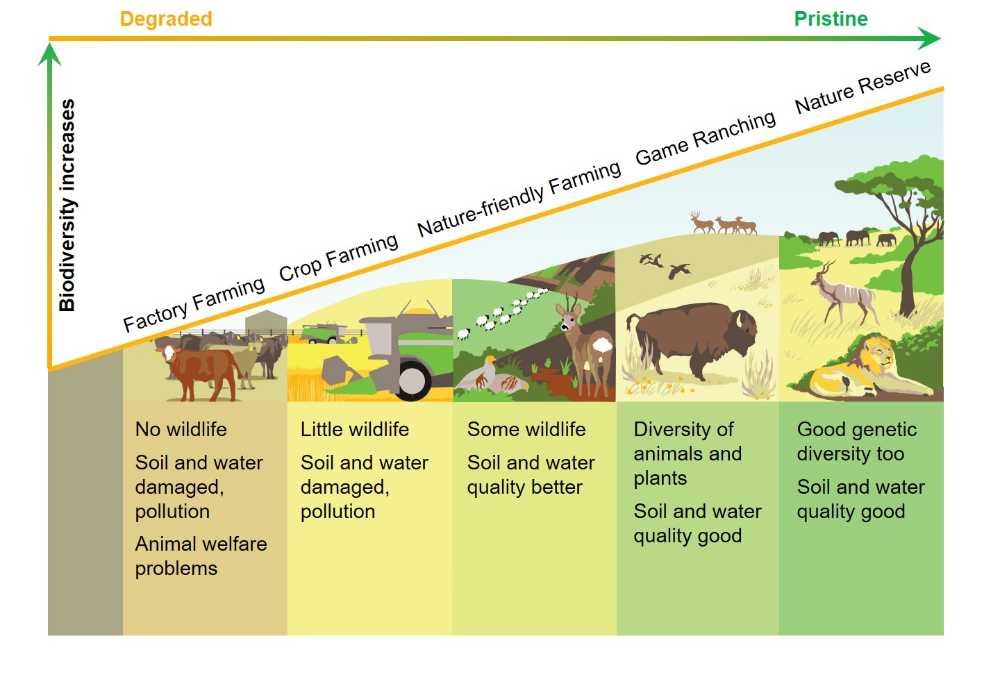Protecting nature

How nature's riches change with how we use the land © Chris Heward/GWCT
Protection and management of natural areas and processes is important when pressure on nature is great. Refuge areas are essential for species easily lost from ecosystems, so that there is stock for restoration. The wealth of species in remaining pristine areas of some tropical countries is already high and can be preserved without need for restoration. Beyond such areas, an ideal for protecting organisms and their ecosystems is a conservation continuum, where zones of protection are edged and linked by zones or corridors of natural habitat with reduced use by humans, forming a mosaic. If nature reserves become islands in a sea of intensive use, they risk spill-over of pollutants or loss of water and they are less able to retain populations of rare species. Zoning also enables communities to engage widely in local conservation rather than pay for travel and entry to nature-rich areas. In Namibia, South Africa and Zimbabwe, more land and larger wildlife populations are managed outside National Parks than in them, through hunting as well as watching them. Such zoning is especially appropriate for species which local communities tolerate only if any damage they cause can be offset by benefits from hunting or other uses. What pays, stays.
Restoring and enhancing nature
_636882394107943414.jpg)
Restoring coastal mangrove, photo © Marco Quesada
Despite achieving some protection for about 15% of land globally, ecosystems used by humans continue to be degraded and species are widely lost locally through intensified human demand for food and materials. Problems from human infrastructure, such as roads, dams, powerlines and wind-turbines can often be reduced if appropriate knowledge is applied. If habitat loss is the problem, quite small changes in land management, which sometimes actually benefit farming, forestry and gardening, can have dramatic effects on the riches of nature. Nest boxes, ‘beetle banks’, buffer strips and land-use diversification are all good examples. Far more work is needed on this ‘reconciliation ecology’ and its seamless integration into management of land (including cities) and infra-structure.
If harvest of wild foods departs from previously sustainable levels, especially of meat for markets in growing towns, it is essential to agree protective measures with communities, based on modern science and traditional knowledge. Widespread adoption of community conservation has been delayed by societies which have not wanted to devolve responsibility for ecosystem management to the lowest appropriate level (the ‘ecosystem approach’), and through a belief that it is better for development to be opposed than for management and restoration to be used to compensate for the human impacts. Although restoration is widely mentioned in official strategy, implementation is poor. Governments and other bodies need to cooperate better for restoration, both with local communities and with communities of all those interested in land and wild species. Communities of interest can have special roles, as when falconers develop bird-safe power-lines and bird-watchers seek careful placement of wind-farms.
Urban ecosystems
_550208989_636903180394375316.jpg)
A diversity of plants encourages animal diversity too © Jamesteohart/Shutterstock
Preserving and rebuilding the riches of nature should embrace not only rural but also urban areas, because everyone depends on nature for food, fresh water, breathable air and stable climate. Gardens, parks, ‘green lungs’ and ‘emerald necklaces’ to block urban sprawl can all bring benefits, because management of services for human and other life is needed everywhere. Moreover, people living in towns often return to the countryside, and need to understand nature if they are to contribute usefully to rural communities.